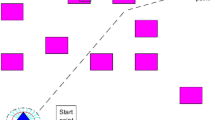Abstract
Evolutionary computation has been often used for the design of mobile robot controllers thanks to its flexibility and global search ability. A lot of studies have been done based on single-objective functions including weighted-sum scalarizing objective functions. For an example of mobile robot navigation, at least the minimization of the arrival time to the target and the minimization of dangerous situations should be considered. In this case, a weighted-sum of two objectives is always minimized. It is, however, difficult to specify an appropriate weight vector beforehand. This paper demonstrates the application of evolutionary multiobjective optimization to mobile robot navigation in order to optimize the conflicting objective simultaneously. We analyze the obtained non-dominated controllers through simulation experiments in multiagent environments. We also show the utilization of the obtained non-dominated controllers for situation change.
Access this chapter
Tax calculation will be finalised at checkout
Purchases are for personal use only
Preview
Unable to display preview. Download preview PDF.
Similar content being viewed by others
References
Cliff, D., Harvey, I., Husband, P.: Explorations in Evolutionary Robotics. Adaptive Behavior 2, 73–110 (1993)
Nolfi, S., Floreano, D.: Evolutionary Robotics: The Biology, Intelligence, and Technology of Self-Organizing Machines. The MIT Press (2000)
Hoffmann, F., Pfister, G.: Evolutionary Design of a Fuzzy Knowledge Base for Mobile Robot. International Journal of Approximate Reasoning 17, 447–460 (1997)
Kubota, N., Morioka, T., Kojima, F., Fukuda, T.: Learning of Mobile Robots using Perception-based Genetic Algorithm. Measurement 29, 237–248 (2001)
Hoffmann, F., Schauten, D., Holemann, S.: Incremental Evolutionary Design of TSK Fuzzy Controllers. IEEE Trans. on Fuzzy Systems 15(4) (August 2007)
Vadakkepat, P., Peng, X., Kiat, Q.B., Heng, L.T.: Evolution of Fuzzy Behaviors for Multi-robotic Systems. Robotics and Autonomous Systems 55, 146–161 (2007)
Deb, K.: Multi-Objective Optimization Using Evolutionary Algorithms. John Wiley & Sons, Chichester (2001)
Coello, C.A.C., van Veldhuizen, D.A., Lamont, G.B.: Evolutionary Algorithms for Solving Multi-Objective Problems. Kluwer, Boston (2002)
Capi, G.: Multiobjective Evolution of Neural Controllers and Task Complexity. IEEE Trans. on Robotics 23(6) (December 2007)
Kim, J.-H., Kim, Y.-H., Choi, S.-H., Park, I.-W.: Evolutionary Multi-objective Optimization in Robot Soccer System for Education. IEEE Computational Intelligence Magazin, 31–41 (February 2009)
Katada, Y.: Distribution of Non-dominated Solutions and Preferred Solutions in the Objective Function Space for an Evolutionary Multi-objective Mobile Robot. In: Proc. of Joint 5th International Conference on Soft Computing and Intelligent Systems and 11th International Symposium on Advanced Intelligent Systems, pp. 710–715 (2010)
Knowles, J.D., Watson, R.A., Corne, D.W.: Reducing Local Optima in Single-Objective Problems by Multi-Objectivization. In: Zitzler, E., Deb, K., Thiele, L., Coello Coello, C.A., Corne, D.W. (eds.) EMO 2001. LNCS, vol. 1993, pp. 269–283. Springer, Heidelberg (2001)
Jensen, M.T.: Guiding Single-Objective Optimization Using Multi-objective Methods. In: Raidl, G.R., Cagnoni, S., Cardalda, J.J.R., Corne, D.W., Gottlieb, J., Guillot, A., Hart, E., Johnson, C.G., Marchiori, E., Meyer, J.-A., Middendorf, M. (eds.) EvoIASP 2003, EvoWorkshops 2003, EvoSTIM 2003, EvoROB/EvoRobot 2003, EvoCOP 2003, EvoBIO 2003, and EvoMUSART 2003. LNCS, vol. 2611, pp. 268–279. Springer, Heidelberg (2003)
Nojima, Y.: Multi-objective Behavior Coordination based on Sensory Network for Multiple Mobile Robots. In: Proc. of 2009 IEEE Workshop on Robotic Intelligence in Informationally Structured Space, pp. 66–72 (2009)
Brooks, R.A.: A Robust Layered Control System for a Mobile Robot. IEEE Journal of Robotics and Automation RA-2, 14–23 (1986)
Brooks, R.A.: Cambrian Intelligence. The MIT Press (1999)
Arkin, R.C.: Behavior-Based Robotics. The MIT Press (1998)
Saffiotti, A.: The Use of Fuzzy Logic in Autonomous Robot Navigation. Soft Computing 1, 180–197 (1997)
Bonarini, A., Invernizzi, G., Labella, T.H., Matteucci, M.: An Architecture to Coordinate Fuzzy Behaviors to Control an Autonomous Robot. Fuzzy Sets and Systems 134, 101–115 (2003)
Nojima, Y., Kubota, N., Kojima, F., Fukuda, T.: Control of Behavior Dimension for Mobile Robots. In: Proc. of The Forth Asian Fuzzy Systems Symposium, pp. 652–657 (2003)
Fukuda, T., Kubota, N.: An Intelligent Robotic System based on a Fuzzy Approach. Proceedings of IEEE 87(9), 1448–1470 (1999)
Deb, K., Pratap, A., Agarwal, S., Meyarivan, T.: A Fast and Elitist Multiobjective Genetic Algorithm: NSGA-II. IEEE Trans. on Evolutionary Computation 6(2), 182–197 (2002)
Eshelman, L.J., Schaffer, J.D.: Real-coded Genetic Algorithms and Interval-Schemata. In: Foundations of Genetic Algorithms, vol. 2, pp. 187–202. Morgan Kaufman, San Mateo (1993)
Author information
Authors and Affiliations
Editor information
Editors and Affiliations
Rights and permissions
Copyright information
© 2011 Springer-Verlag Berlin Heidelberg
About this paper
Cite this paper
Nojima, Y., Ishibuchi, H. (2011). Mobile Robot Controller Design by Evolutionary Multiobjective Optimization in Multiagent Environments. In: Jeschke, S., Liu, H., Schilberg, D. (eds) Intelligent Robotics and Applications. ICIRA 2011. Lecture Notes in Computer Science(), vol 7102. Springer, Berlin, Heidelberg. https://doi.org/10.1007/978-3-642-25489-5_50
Download citation
DOI: https://doi.org/10.1007/978-3-642-25489-5_50
Publisher Name: Springer, Berlin, Heidelberg
Print ISBN: 978-3-642-25488-8
Online ISBN: 978-3-642-25489-5
eBook Packages: Computer ScienceComputer Science (R0)




